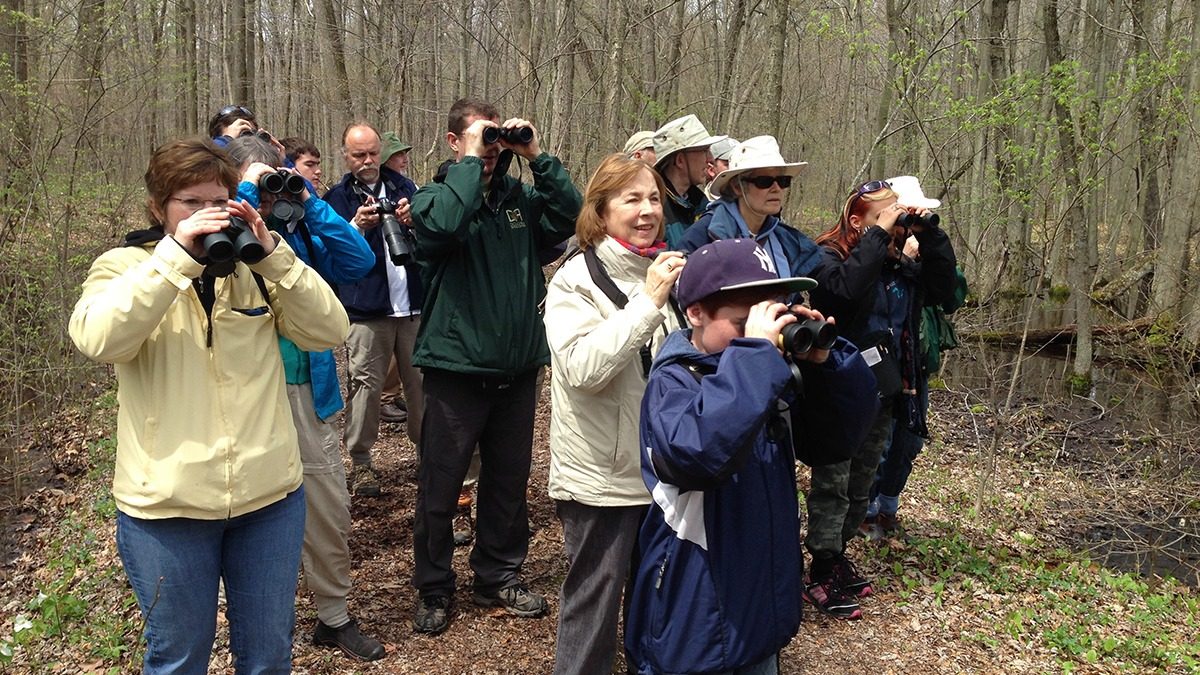Acadian Flycatcher
Empidonax virescens
COSEWIC status: Endangered
Estimated Canadian population (individuals): 110
Appearance and population trend
Acadian Flycatchers look like other members of the Empidonax group of flycatchers; however, its larger size, more olive-green colouration, and longer tail can be distinguishing features. Song is the best clue to identifying them as physical features can be hard to see in the field. Acadian Flycatchers have a one-note song that sounds akin to a squeaky toy as opposed to the harsher or buzzier calls of other flycatchers. From 1970 – 2014, the continental Acadian Flycatcher population has declined 10% but data from 2005 shows the population is on the rise (Rosenberg et al. 2016). The Canadian population appears to be stable for over the past decade. Population stability is most likely related to immigration from the United States than the Canadian population being self-sustaining (COSEWIC 2010).
Location and habitat
In Canada, Acadian Flycatchers are found exclusively in the Carolinian region of southwestern Ontario. Their breeding habitats are mature forests with a large interior (more than 40 hectares) or forested ravines. Acadian Flycatchers actively avoid edge habitats, establishing territories at least 100 m from the forest’s edge. However, in ravines, they are more tolerant of forest edges as ravine corridors might only be 80-85 m wide (Friesen et al. 2000). Breeding territories will have a closed canopy with an open understory, composed of a mix of American Beech, softwood maples, Eastern Hemlock, and Flowering Dogwood. They build their nests above a water source such as a stream or vernal (springtime) pool, about 3 to 9 m above the ground (Whitehead and Taylor 2002).
Threats
Habitat loss and degradation are the biggest threats to Acadian Flycatchers. Diameter-limit tree harvest is a common silviculture practice where the oldest and largest trees are harvested, drastically reducing the canopy cover. Invasive species and pathogens are of concern in breeding habitat. Beech bark disease and Hemlock Woolly Adelgid can kill a large portion of their preferred nesting tree species, and Acadian Flycatchers will not breed in ravines with Multiflora Rose and/or Garlic Mustard even if the trees are suitable (Environment Canada 2012).
What Birds Canada is doing
The Ontario Forest Birds at Risk (OFBAR) program works to maintain habitat at known breeding sites and actively surveys potential habitat within this species’ range in Ontario. The OFBAR program conducts forest health surveys to mark any threats to woodlots such as invasive species and tree pathogens. OFBAR also discusses woodlot management, invasive species mitigation, and tree pathogens with landowners, working with them to maintain suitable breeding habitat for Acadian Flycatchers.
Best Management Practices for Acadian Flycatchers
- Do not harvest between the beginning of May to the end of August;
- Avoid cutting and placing off-road vehicle trails in suitable habitat;
- Keep forest interiors intact by not creating edge habitat within 100 m of suitable habitat;
- Enhance or restore suitable forests by thinning the midstory so that sufficient light can regenerate saplings;
- Maintain the hydrology of the forest or treed swamp;
- Protect and restore large intact tracts of mature forests.
Interesting facts
Acadian Flycatchers spend their winters in the lowlands and pre-mountain forests of Central America and South America.
Acadian Flycatchers are very site-faithful when it comes to their wintering grounds as well as their breeding grounds, with the same individuals occupying the same site multiple years in a row.
The high use of Eastern Hemlock and Flowering Dogwood for nesting was discovered in Ontario in the 2000s (COSEWIC 2010)
References
COSEWIC. 2010. COSEWIC assessment and status report on the Acadian Flycatcher Empidonax virescens in Canada. Committee on the Status of Endangered Wildlife in Canada. Ottawa. x + 28 pp. (www.sararegistry.gc.ca/status/status_e.cfm).
Environment Canada. 2012. Recovery strategy for the Acadian Flycatcher (Empidonax virescens) and the Hooded Warbler (Wilsonia citrina) in Canada. Species at Risk Act Recovery Strategy Series. Environment Canada, Ottawa, Ontario. viii + 32 pp.
Friesen L., M. Cadman, P. Carson, K. Elliott, M. Gartshore, D. Martin, J. McCracken, J. Oliver, P. Prevett, B. Stutchbury, D. Sutherland, and A. Woodliffe. 2000. National Recovery Plan for Acadian Flycatcher (Empidonax virescens), and Hooded Warbler (Wilsonia citrina). National Recovery Plan No. 20. Recovery of National Endangered Wildlife (RENEW). Ottawa, ON. 22 pp.
Rosenberg, K. V., J. A. Kennedy, R. Dettmers, R. P. Ford, D. Reynolds, J. D. Alexander, C. J. Beardmore, P. J. Blancher, R. E. Bogart, G. S. Butcher, A. F. Camfield, A. Couturier, D. W. Demarest, W. E. Easton, J. J. Giocomo, R. H. Keller, A. E. Mini, A. O. Panjabi, D. N. Pashley, T. D. Rich, J. M. Ruth, H. Stabins, J. Stanton, and T. Will (2016). Partners in Flight Landbird Conservation Plan: 2016 Revision for Canada and Continental United States. Partners in Flight Science Committee.https://www-partnersinflight-org.proxy1.lib.uwo.ca/resources/the-plan/
Whitehead, D.R. and T. Taylor. 2002. Acadian Flycatcher (Empidonax virescens). In The Birds of North America Online (A. Poole, ed.). Cornell Lab of Ornithology, Ithaca, NY. http://bna.birds.cornell.edu.proxy1.lib.uwo.ca:2048/bna/species/614
Species at Risk Profiles

Cerulean Warbler
Endangered

Louisiana Waterthrush
Threatened

Prothonotary Warbler
Endangered

Red-headed Woodpecker
Endangered

